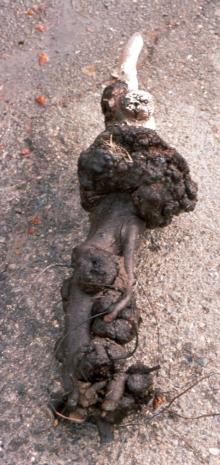Cause The bacteria Rhizobium radiobacter (formerly Agrobacterium tumefaciens) and R. rhizogenes (formerly A. rhizogenes). As galls in soil break down, bacteria are released and can be transported by moving soil or water. Pathogenic bacteria can also be spread by pruning equipment. In the absence of tree roots, bacterial populations gradually decrease, but the pathogen may survive in soil at least 2 years. Long-distance transport is through shipment of diseased plants.
Bacteria enter trees through wounds, either natural or caused by pruning, grafting, mechanical injury from cultivation, chewing insects, or the emergence of lateral roots. The bacteria overwinter in the roots and can repopulate above ground portions in the spring. This systemic population of bacteria can cause disease in many different parts of the tree. After the bacterium enters a wound, a small piece of its DNA is transferred into the tree's DNA. The "foreign" DNA transforms normal cells in the wounded area into tumor cells. Once transformed, tumor cells proliferate automatically. The result is a gall, a disorganized mass of hyperplastic and hypertophic tissue. If infection occurs below 60°F, galls may not form until the next two growing seasons.
The walnut rootstock Paradox is much more susceptible than black or English walnut especially under nursery conditions. The rootstock RX1 has moderate to low resistance, VX211 is low and Vlach is susceptible. Trees less than 8-years old are more damaged than older trees. Nuts collected from tree canopies do not have the bacteria while nuts collected after falling to the ground are contaminated.
Symptoms Galls are often at or just below the soil surface on roots and at the transition zone between root and trunk sometimes referred to as the root crown. They may frequently be on roots but less frequently above ground on the trunk. Galls usually are rounded with a rough, irregular surface. They appear as small protuberances on the plant surface. Young, actively developing galls are light green or nearly white, and tissue is soft. As galls age, they become darker and woody. Outer portions can slough off with age. Sometimes galls have a rather smooth surface, which makes it difficult to distinguish between gall and callus growth, especially if the gall is at the plant base or at the graft or bud union. Galls may continue to grow and reach a diameter of 10 inches or more on older trees. Neither bacterial streaming nor ooze is associated with gall tissue. Severe galling of young trees weakens the trees, disrupting vascular flow, which results in stunting and death. Nut production is reduced when young trees are infected.
Cultural control
- Use only pathogen-free nursery stock. Inspect new plants; do not plant any with galls.
- Avoid planting in sites with a recent history of crown gall.
- Avoid wounding plants, especially at planting. If root pruning at planting, soak in biocontrol agent listed below.
- For a few trees with galls, use a hatchet and chisel to remove galled tissue, and then remove a ring of bark from around the galled area. A propane torch can then be used to heat, dry and sterilize that area.
- Remove and destroy badly affected plants.
- Preplant soil solarization has been effective for cherry nursery stock in western Oregon. Place clear plastic (preferably anti-condensation film) directly on smooth, rototilled ground, which has been irrigated to field capacity and then allowed to drain for 1-2 days. Bury the edges of the plastic to trap the heat. Solarize for 4-6 weeks (or longer) during the hottest part of the summer, beginning in early- to mid-July. This technique may be helpful after diseased trees are removed from a site on which walnut trees are to be planted again.
- Sanitize grafting and cutting equipment frequently in nursery production.
Chemical control
- Gallex (ready to use) painted on very young galls to reduce further development. Galls may return the following year or, if treated late, may continue to develop. Tissue surrounding the gall may be injured, especially on younger plants. Prepare the surface by removing soil from around the galled area, and allow the area to dry before applying. Not registered in Idaho. 24-hr reentry.
Biological control Agrobacterium radiobacter K84 is preventive only. Latent infections (symptomless) and existing galls are not controlled. A suspension of Strain 84 may be used as a soak or spray. Thoroughly cover grafting wood, roots, and lowest trunk regions. Spray to runoff. To be effective it must be applied a few hours after wounding.
- Galltrol-A (Agrobacterium radiobacter K84). Not registered in Idaho. 12-hr reentry. O
- NOGALL at 8.8 oz/2.5 gal unchlorinated water per 2,500 nonbearing plants. Apply within 2 hours of lifting and/or damaging plants. Do not use with any pesticides or fertilizers. 4-hr reentry. O
Reference Yakabe, L.E., Parker, S.R., and Kluepfel, D.A. 2012. Role of systemic Agrobacterium tumefaciens populations in crown gall incidence on the walnut hybrid rootstock 'Paradox'. Plant Disease 96:1415-1421.


